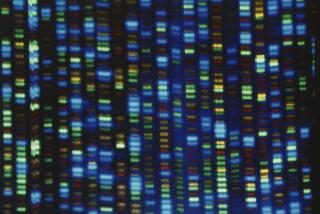Researchers find way to assemble full genome of fetus
- Share via
Researchers have found a way to collect and decode the complete DNA sequence of a fetus by piecing it together using a sample of its mother’s blood.
The discovery, reported online Wednesday in the journal Science Translational Medicine, could present a safer alternative to the invasive procedures currently used to detect genetic problems in fetuses, experts said. Amniocentesis and chorionic villus sampling carry a small but real risk of miscarriage and are generally reserved for cases when the risk of a genetic defect is elevated.
“It has major clinical implications for the future,” said Dr. W. Allen Hogge, an ob-gyn at the University of Pittsburgh who wasn’t involved in the study. If made relatively fast and cheap, he said, the procedure could be used to screen for a variety of genetic conditions at once.
The successful mapping of one couple’s fetus was made possible after researchers from the Chinese University of Hong Kong found in 1997 that the fetus released DNA into its mother’s plasma. Chemical pathologist Y.M. Dennis Lo, the team’s leader, wanted to find out whether the baby’s entire genome — not just random fragments — was present in the mother’s blood.
It wasn’t an easy task. The fetal DNA was broken up into tiny pieces of about 150 base pairs each; a complete genome contains about 3 billion base pairs.
“It’s like trying to assemble a jigsaw puzzle with millions of DNA molecules,” Lo said.
To make matters more complicated, these fragments made up just 10% of the DNA swimming in the plasma. The other 90% were slightly longer chunks of the mother’s DNA. How could they possibly piece together the baby’s unique genetic code?
A 3-D “ Harry Potter” movie provided inspiration. In the opening credits, when a giant letter “H” hurtled toward him from the screen, Lo contemplated its shape — two sticks connected by a bar — and realized how he could use the parents’ DNA for help.
Lo likened it to the bamboo scaffolding that clings to Hong Kong buildings in need of fresh paint. He realized he could use the parents’ genomes as a sort of scaffold for “support” to link the baby’s DNA fragments together.
“Just like when you’re assembling from the jigsaw puzzle, you need to take a look at the original picture,” he said.
Lo’s team tested his approach with a couple who wanted to test their 12-week-old fetus for beta-thalassemia, a potentially deadly blood disorder. Each parent carried a defective gene, giving the baby a 25% chance of having it.
The father’s mutated gene was easily identified from the mother’s blood. The baby’s maternal genes, mixed up among those of the mother, were more difficult to pick out. Eventually, the team discovered that the baby had inherited the mother’s healthy gene and would only be a carrier of the disease.
“The major advantage of the technique in this paper is that there’s no risk of miscarriage,” said Dr. Diana W. Bianchi, a reproductive geneticist at Tufts University who called the work a “technological tour de force.” Amniocentesis and CVS testing carry about a 1% risk of miscarriage, she said.
But mapping this child’s genome cost about $200,000, Lo said. The diagnostic tests used today typically cost between $3,000 and $5,000 and are usually covered by health insurance.
However, if blood-based genetic screening became more affordable and more parents opted to take a peek at their baby’s DNA, they and their doctors could wind up facing some unexpected issues, Bianchi said.
“You can be getting a lot of information you didn’t ask for,” she said. “What if you find out this fetus has mutations, but you don’t understand the clinical significance of them? How will you deal with this?”







